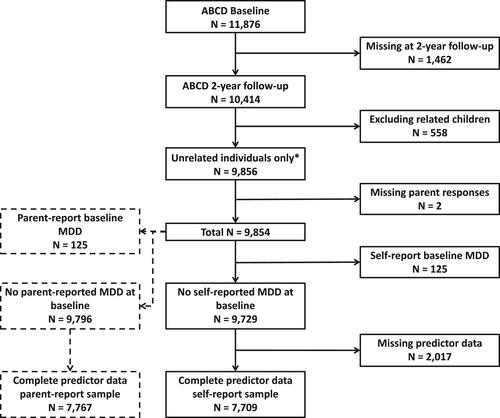Assessing a prediction model for depression risk using an early adolescent sample with self-reported depression
Abstract
Background
Major depressive disorder (MDD) in adolescence is a risk factor for poor physical and psychiatric outcomes in adulthood, with earlier age of onset associated with poorer outcomes. Identifying Depression Early in Adolescence Risk Score (IDEA-RS) is a model for predicting MDD in youth aged >15 years, but replication in younger samples (<15 years) is lacking. Here, we tested IDEA-RS in a younger sample (9–11 years) to assess whether IDEA-RS could be applied to earlier onset depression.
Methods
We applied IDEA-RS predictor weights to 9854 adolescents (9–11 years) from the Adolescent Brain Cognitive Development (ABCD) Study, United States. We derived incident depression outcomes from self-reported data at 2-year follow-up (11–13 years): incident MDD and increase in depression symptoms (DS). Sensitivity analyses were conducted using parent-reported data. We assessed accuracy and calibration in predicting self-reported incident depression and compared this to a refitted model with predictor weights derived in ABCD. Lastly, we tested associations between IDEA-RS predictors and self-reported incident depression.
Results
External replication yielded better-than-chance discriminative capacity for self-reported incident depression (MDD: AUC = 61.4%, 95% CI = 53.5%–69.4%; DS: AUC = 57.9%, 95% CI = 54.6%–61.3%) but showed poor calibration with overly extreme risk estimates. Re-estimating predictor weights improved discriminative capacity (MDD: AUC = 75.9%, 95% CI = 70.3%–81.4%; DS: AUC = 64.8%, 95% CI = 61.9%–67.7%) and calibration. IDEA-RS predictors ‘poorest level of relationship with the primary caregiver’ (OR = 4.25, 95% CI = 1.73–10.41) and ‘high/highest levels of family conflict’ (OR = 3.36 [95% CI = 1.34–8.43] and OR = 3.76 [95% CI = 1.50–9.38], respectively) showed greatest associations with self-reported incident MDD.
Conclusions
While IDEA-RS yields better-than-chance predictions on external replication, accuracy is improved when differences between samples, such as case-control mix, are adjusted for. IDEA-RS may be more suited to research settings with sufficient data for refitting. Altogether, we find that IDEA-RS can be generalisable to early adolescents after refitting and that family dysfunction may be especially impactful for this period of development.





 求助内容:
求助内容: 应助结果提醒方式:
应助结果提醒方式:


